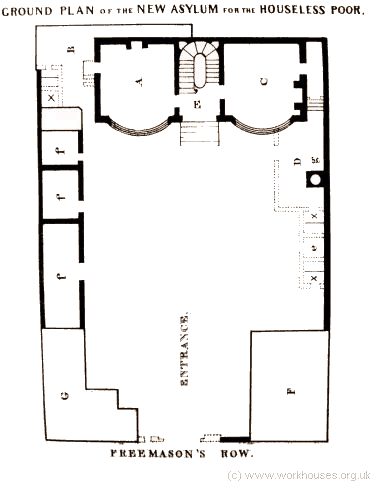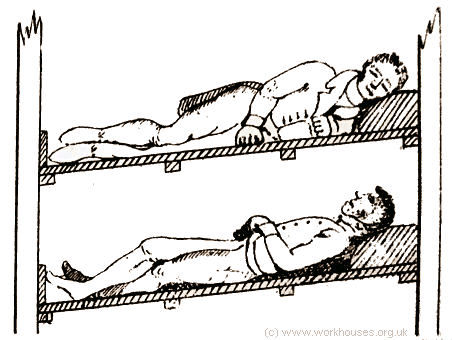Liverpool Night Asylum
Liverpool may have claim to be the first city in England to set up charitably run night shelters for the destitute. Temporary "night asylums" for the reception of the "houseless poor" were set up in Liverpool in the winters of 1816 (in a vacant guard house in Chapel Street), 1820 (South Union Street), 1821 (Blundell Street), 1822 (South Union Street), and 1829 (Thomas Street and Shaw's Brow).
In 1830 it was decided to establish a permanent night shelter on Freemason's Row, funded by contributions from the city's gentlemen and merchants. The premises adopted for the scheme, a large double house with a spacious yard in front, were "unsuitable for respectable tenants, on account of being in the immediate vicinity of the most indigent part of the Liverpool population". The dilapidated property was acquired at the bargain price of £30 and was substantially rebuilt. Cisterns were provided, water-pipes laid down, soughs excavated, and arrangements made for warming and ventilating the house. The ceilings of the lower room were fireproofed, so as to remove all danger of any fire spreading to the upper rooms, where the majority of the male inmates were to sleep. A ground-floor plan of the site is shown below.

Liverpool Night Asylum ground floor plan, 1838.
© Peter Higginbotham
In the house which stood at the rear of the site, room A, a cellar beneath, and yard B were reserved for the resident superintendent and his family. Room C and yard D were used by the female lodgers. The rooms above A and C were used by seamen and other male lodgers, with some additional small rooms on the second floor. The former stables (labeled "f" on the plan) were used for storing coal, wood, and straw. Areas F and G were not part of the shelter. Entrance to the premises was through a pair of large folding gates or small door from Freemason's Row.
The shelter's inmates slept on sloping wooden beds ranged along the wail in three tiers, one above the other.

Liverpool Night Asylum dormitory beds, 1838.
© Peter Higginbotham
Great effort was made to keep the establishment clean, with the interior being frequently whitewashed, the sleeping forms washed down, and the use of chloride of lime and the burning of tar to purify the atmosphere.
A large sign-board in front of the shelter carried the following inscription:
FOR THE
HOUSELESS POOR.
"Knock, and it shall be opened unto yea."
Luke, chap. 11 v. 9.
The rules and regulations to be observed by the lodgers at the shelter were as follows:
2nd. No person to be admitted in a state of intoxication. Persons who remain all night must wash themselves next morning.
3rd. Inmates to keep their respective rooms clean; and those who will not assist to do so will not be allowed to remain.
4th. No nails must be driven in the walls; nor must they be otherwise defaced. The rooms to be fumigated once every day; and it is requested that great care be taken to avoid setting the apartments on fire.
5th. The rugs, blankets. &c., to be taken out every morning to the yard, to be shaken there, and afterwards to be returned to the rooms and folded up.
6th. No blasphemous or indecent expressions, fighting, loud talking, singing, or gambling, will be allowed; and those who violate this rule will be turned out.
7th. The Asylum to be cleared of its inmates every day from Ten to Twelve o'clock. The street door to be locked every evening at Six o'clock. No person belonging to the Asylum, that is rut, will be admitted after that hour.
8th. No person to take any bundle or parcel from the Asylum without their previous examination by the Superintendent.
9th. No clothes, potatoes, or any other food, to be washed in the rooms, but at the trough in the yard.
10th. The men are not to climb over the gate, the wall, or any other part of the building; any of the inmates so offending shall be dismissed from the Asylum.
N.B. The inmates are cautioned not to be seen begging in the streets.
The shelter opened on December 25th, 1830. In its first year of operation, a total of 33,165 "berths" were provided and 6,122 persons were admitted, with each lodger staying an average of 5-6 nights. Of the total berths, 11,230 were used by seamen, 15,391 by mechanics and labourers, 3,876 by women, 1,328 by boys, 776 by girls, and 564 by young children. By the end of 1838, over 120,000 berths had been provided.
Bibliography
- Smith, Egerton (1838) Description of the Liverpool Night Asylum for the Houseless Poor in Freemason's Row. (Liverpool: Egerton Smith)
Links
- None.
Unless otherwise indicated, this page () is copyright Peter Higginbotham. Contents may not be reproduced without permission.


